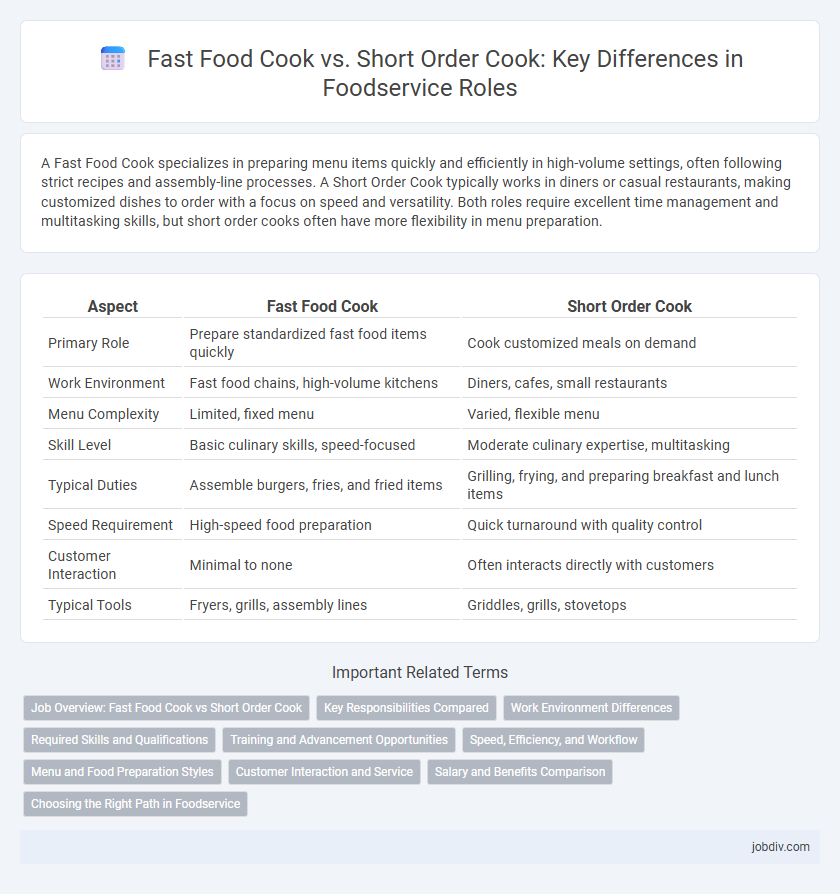A Fast Food Cook specializes in preparing menu items quickly and efficiently in high-volume settings, often following strict recipes and assembly-line processes. A Short Order Cook typically works in diners or casual restaurants, making customized dishes to order with a focus on speed and versatility. Both roles require excellent time management and multitasking skills, but short order cooks often have more flexibility in menu preparation.
Table of Comparison
| Aspect | Fast Food Cook | Short Order Cook |
|---|---|---|
| Primary Role | Prepare standardized fast food items quickly | Cook customized meals on demand |
| Work Environment | Fast food chains, high-volume kitchens | Diners, cafes, small restaurants |
| Menu Complexity | Limited, fixed menu | Varied, flexible menu |
| Skill Level | Basic culinary skills, speed-focused | Moderate culinary expertise, multitasking |
| Typical Duties | Assemble burgers, fries, and fried items | Grilling, frying, and preparing breakfast and lunch items |
| Speed Requirement | High-speed food preparation | Quick turnaround with quality control |
| Customer Interaction | Minimal to none | Often interacts directly with customers |
| Typical Tools | Fryers, grills, assembly lines | Griddles, grills, stovetops |
Job Overview: Fast Food Cook vs Short Order Cook
Fast Food Cooks prepare standardized menu items quickly and efficiently in high-volume environments, specializing in operating fryers, grills, and assembly lines to maintain fast service. Short Order Cooks handle a broader range of customized orders, focusing on cooking personalized meals to order, often working on griddles and stoves with an emphasis on speed and accuracy. Both roles require strong multitasking skills but differ in the complexity and customization of food preparation.
Key Responsibilities Compared
Fast food cooks prioritize speed and consistency, preparing standardized menu items like burgers and fries using assembly-line techniques to meet high customer volume demands. Short order cooks handle a wider variety of dishes, often customizing each order and cooking to order on griddles or fryers, focusing on freshness and rapid turnaround for breakfast, lunch, or diner-style menus. Both roles require efficient multitasking, but short order cooks engage more in direct order customization and menu versatility.
Work Environment Differences
Fast food cooks typically work in high-volume chains with fast-paced, repetitive tasks focused on assembly-line efficiency and minimal menu variations. Short order cooks operate in diner-style or casual restaurants, preparing customized orders with a wider variety of dishes in a more interactive and dynamic kitchen environment. Noise levels and time pressure are intense for both, but short order cooks benefit from more direct customer interaction and varied cooking techniques.
Required Skills and Qualifications
Fast Food Cooks require speed, multitasking, and knowledge of standardized menu items with basic food safety certifications such as ServSafe. Short Order Cooks need strong cooking skills, versatility in preparing diverse dishes quickly, and familiarity with traditional kitchen equipment, often possessing culinary training or on-the-job experience. Both roles demand effective time management, attention to detail, and the ability to work efficiently in fast-paced environments.
Training and Advancement Opportunities
Fast food cooks typically receive standardized training focused on assembly-line food preparation and equipment operation, enabling rapid onboarding and consistency in service. Short order cooks undergo more comprehensive training in diverse cooking techniques and menu customization, fostering skill development that supports career advancement into supervisory or chef roles. Advancement opportunities for short order cooks are broader due to their versatile culinary skills, while fast food cooks often progress within chain management or franchise operations.
Speed, Efficiency, and Workflow
Fast food cooks prioritize speed and efficiency by preparing standardized menu items with batch cooking techniques, ensuring quick service during peak hours. Short order cooks focus on customized, made-to-order dishes, requiring a flexible workflow to manage diverse customer requests rapidly. Both roles optimize kitchen processes, but fast food cooks emphasize volume and consistency, while short order cooks balance speed with culinary variation.
Menu and Food Preparation Styles
Fast food cooks primarily focus on highly standardized menus featuring quick-prep items like burgers, fries, and fried chicken, using automated or assembly-line cooking methods to ensure speed and consistency. Short order cooks handle more diverse menus with freshly prepared dishes such as omelets, sandwiches, and grilled items, requiring flexible cooking techniques and on-demand food preparation. Both roles demand efficiency, but short order cooks emphasize customization and immediate meal assembly tailored to individual customer orders.
Customer Interaction and Service
Fast food cooks primarily focus on rapid food preparation with minimal direct customer interaction, ensuring quick service to meet high demand. Short order cooks engage more frequently with customers, often preparing made-to-order meals and adjusting dishes based on specific preferences or requests. This closer interaction enhances personalized service, catering to individual customer needs in fast-paced foodservice environments.
Salary and Benefits Comparison
Fast food cooks typically earn an average hourly wage of $11 to $14, with limited benefits such as basic health insurance and employee meal discounts, reflecting the entry-level nature of the role. Short order cooks usually command higher wages, ranging from $13 to $17 per hour, often accompanied by more comprehensive benefits packages including health, dental, and retirement plans due to the specialized skills required. Salary differences are influenced by the complexity of food preparation and the dining environment, with short order cooks positioned in establishments that prioritize quick, made-to-order meals.
Choosing the Right Path in Foodservice
Fast food cooks specialize in high-speed preparation of standardized menu items within chain restaurants, emphasizing efficiency and consistency. Short order cooks handle a broader range of freshly prepared dishes, often in diner or cafe settings, requiring versatile cooking skills and immediate order fulfillment. Choosing between these roles depends on whether one prefers a structured, rapid environment or a dynamic, customizable cooking experience in foodservice.
Fast Food Cook vs Short Order Cook Infographic

 jobdiv.com
jobdiv.com